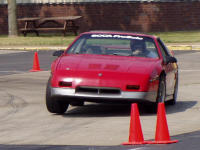VFD calculation.
- arvidb
-

- Offline
- Platinum Member
-

Less
More
- Posts: 459
- Thank you received: 158
27 Sep 2022 17:22 #252869
by arvidb
(Besides, if the motor is correctly dimensioned for its task, it will simply not draw more current than it can handle in the first place. Well, unless it is ran at overvoltage or overspeed.)
Replied by arvidb on topic VFD calculation.
The VFD has to have at least the same power rating as the motor. Larger is okay. You then program the VFD with the motor parameters (max current, speed etc) so that the VFD does not overload the motor.For my surprise, it was 1.5KW Fuji motor and 3,7KW Fuji VFD.
This works since more than 10 years with millions of tool change.
I try to get some rules how to put motor and VFD together but i am now back on start line.
I don't understand why this system works. It must be somthing more as put motor and VFD power together.
First note to me, Source power and driver must be equal.
Open question, How to select motor and VDF power?
(Besides, if the motor is correctly dimensioned for its task, it will simply not draw more current than it can handle in the first place. Well, unless it is ran at overvoltage or overspeed.)
Please Log in or Create an account to join the conversation.
- tommylight
-

- Away
- Moderator
-

Less
More
- Posts: 21088
- Thank you received: 7201
27 Sep 2022 17:52 #252871
by tommylight
Plenty of videos on the net where people try to explain that mess...
I have to side with Todd on this one, do not ask how and why regarding power in US.
I will be missing the good old three phase 220V/380V European stuff if i ever go to US, for sure, at 120 degree phase shift...
Replied by tommylight on topic VFD calculation.
As a US citizen that has yet to step foot in US, i will be having a talk or two with the engineers there as there is no way on earth to have 3 phases at 230V at the same time with 115V to neutral as that automatically implies a 180 degree shift between phases, and physics do not allow having 3 phases at 180 degree shift or two of them will end up being the same phase.Remember single phase is any time you are only using 2 legs of a 3 phase, or a single leg to neutral. (There is no such thing as 2 phase.)
So for example with normal low voltage AC (in the USA) you can have 4 wires (plus a ground), one is neutral, and 3 will be 115v to neutral, any pairing of the 3 hot wires will be 230v single phase, and all 3 together will be 230v 3 phase.
Plenty of videos on the net where people try to explain that mess...
I have to side with Todd on this one, do not ask how and why regarding power in US.
I will be missing the good old three phase 220V/380V European stuff if i ever go to US, for sure, at 120 degree phase shift...
Please Log in or Create an account to join the conversation.
- Todd Zuercher
-

- Offline
- Platinum Member
-

Less
More
- Posts: 4690
- Thank you received: 1434
27 Sep 2022 19:12 #252879
by Todd Zuercher
Replied by Todd Zuercher on topic VFD calculation.
You caught me, I never can remember it all, numbers get jumbled around and reused in the wrong places without really thinking them through. I should have said 120/208v.
The following user(s) said Thank You: tommylight
Please Log in or Create an account to join the conversation.
- jmelson
- Offline
- Moderator
-

Less
More
- Posts: 520
- Thank you received: 126
27 Sep 2022 19:19 #252882
by jmelson
Replied by jmelson on topic VFD calculation.
There is a common 3-phase system in the US, called 120/208 Wye. This system provides 3 separate 120 V single-phase hots to ordinary office loads, plus a common neutral. Also, you have 208 V between any two hots. Most 240 V 3-phase motors will run OK on this 208V 3-phase power, but with slightly increased current. This system is commonly found in apartment buildings and offices.
Another system seen sometimes is center-grounded open delta, where one center-tapped residential transformer is combined with one 240 V transformer to provide center-neutral 120/240V power, plus a 3rd hot wire for true 240 V 3-phase power.
Another system I have run into in old buildings is corner-grounded open delta. There, two 240 v transformers are connected together to provide 240 V 3-phase power, but since one wire is grounded, there are only two "hots". This allows the use of two-pole breakers and a 2-phase breaker panel. I'm pretty sure there will be no new installations of this setup.
Jon
Another system seen sometimes is center-grounded open delta, where one center-tapped residential transformer is combined with one 240 V transformer to provide center-neutral 120/240V power, plus a 3rd hot wire for true 240 V 3-phase power.
Another system I have run into in old buildings is corner-grounded open delta. There, two 240 v transformers are connected together to provide 240 V 3-phase power, but since one wire is grounded, there are only two "hots". This allows the use of two-pole breakers and a 2-phase breaker panel. I'm pretty sure there will be no new installations of this setup.
Jon
The following user(s) said Thank You: tommylight
Please Log in or Create an account to join the conversation.
Moderators: PCW, jmelson
Time to create page: 0.072 seconds
